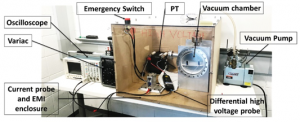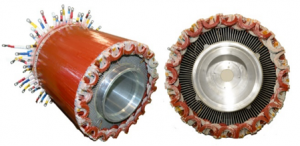Stator assembly and qualification of 1MW high speed permanent magnet synchronous motor
Balachandran Thanatheepan with advisor K. Haran
Advanced high-speed permanent magnet synchronous motors (PMSM) have been the subject of recent research for electric propulsion. A NASA-funded inside-out PMSM is designed and developed to demonstrate the concept of high-power density PM machines for commercial electric aircraft. Air-core windings, which are used in this machine design are manufactured and qualified. As a part of the winding manufacturing and validation process, partial discharge inspection voltage measurements (PDIVM), a 2.5kV breakdown voltage test and a 2.5kV Hi-Pot test are performed on all the windings used in the stator assembly. To facilitate these tests, a (PD test bench setup is built, as shown in Figure 1. Measured PDIV of all the windings used in the stator assembly are shown in Figure 2. Average PDIV observed was 1050V with a minimum of 922.5V. This result is considered as passed, since the operating voltage is 650VLL.
After the winding qualification, the machine stator is assembled and qualified electrically and mechanically. Due to the complexity of the stator assembly, each phase is assembled separately step-by-step. At the end of each phase assembly, the stator is electrically qualified using the PD test bench as well as the megger test. Figure 3 shows the completed stator. As part of the design validation, a life-time prediction model was investigated through an accelerated life-time test. PDIV and PDe extinction voltage are the two parameters used to evaluate the winding qualification. Since the machine is designed to operate at high altitude, windings are tested with varying pressure and temperatures. These results are incorporated into the accelerated aging model to predict the lifetime estimation of the windings.


